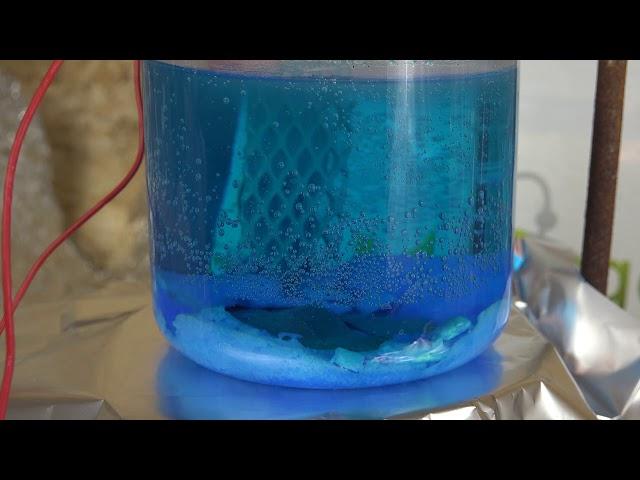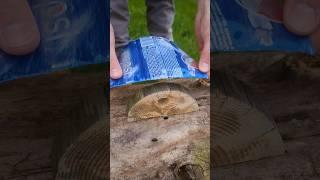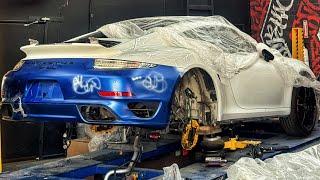
Efficiently Recover Nitric Acid and Copper Metal From Copper Nitrate Wastes
Комментарии:

Cool !!!
Ответить
Any alternative to platinum electrode?
Ответить
Thank you for this! ❤
Ответить
When you talk about Sulfuric acid is it concentrated ? or Dilute Sulfuric acid?
Ответить
Interesting, we can recycle these product to reuse in metal refining.
Ответить
M. Sc. of chemistry here:
Many precious metal people here on YT use iron to get copper out of solution. This creates big amounts of iron solution that is still toxic for the environment and should NEVER be put down the sewer!
Using this electrochemical approach will greatly decrease the amount of costly HM waste. The concentrated HM waste can be precipitated and heated to get the easy to handle HM oxides (zinc, nickel, ....). A proper waste management for gold refiners will greatly reduce their costs and keep our environment clean!
Well done!

What I’m looking for is a better way to collect and trap the contaminants. Instead of using a Platinum Anode, could you use the reactivity series of metals. Add iron to your copper sulfate solution to drop out the copper and all contaminants under iron and then melt up the metal sponge into shot and a connecting anode bar that connects to your power supply. Then for electrolyte use a clean pure form of copper sulfate solution and place the contaminated copper shot into some sort of filter bag that is dipped into the electrolyte. That way all the sludge that forms from impurities and trapped for further processing in the future. Do you have to use Platinum? Is platinum only used because it doesn’t react? In my case I want the anode to be the consumable. Also, must the cathode be copper? Can it be stainless steel? For instance a large surface area stainless bowl?
Ответить
Very useful video. Thanks for sharing
Ответить
Did anyone mention / ask about HCL remaining in the waste copper nitrate solution? Many refiners use HCL to precipitate the silver chloride. Would this have any adverse effects on the sulfuric acid -> distillation of the nitric acid? While the boiling point of HCL is higher than Nitric, i'm not sure about azeotropes or if any HCL would remain in the final distillate.
Ответить
F**** orbeez
Ответить
Sir i have problem in extraction of copper metal from my waste nitrate solution,
When i add iron plate to my nitrate solution iron hydroxide is precipitated instead of copper metal, why this happened and how to avoid it?

Iron is also used by refiners to precipitate the copper out of the copper nitrate, the iron nitrate is then disposed as a waste product.
Ответить
great video, and fantastic insight to recycling re-usable materials. is there a forum to ask questions and solve issues with this experiment?
Ответить
Could you not use a copper pipe for the anode instead of a platnium electrode. I know it will disolve and the copper will transfer over to the cathode as pure copper and the copper pipe will have to be replaced as it disolved. Benifits being copper is cheap and do not have to buy or worry about the platnium electrode.
Ответить
Thank you
Ответить
can you like use grafite electrodes for that?
Ответить
hi strange question but i see you have the same filter as me and i was wondering how you go about cleaning it since no filter paper is used
churs love your work

Excellent video.. thank you!
I'm working on a project to turn about 18kg of mixed scrap of unknown alloy bronzes, into a 25 to 30cm diameter bell of 80Cu/20Sn bell bronze. I doubt that any Ag/Au/PGM are present, but I want to remove any Mn, Si, Zn, or Pb present, and I'd like to separate out the tin, recover it, and supplement it with additional tin in the final melt.
It looks like a dilute nitric acid (a lot of it..) will dissolve the bronze - all the possible components except for the tin, which will either settle out as a tin sludge or precipitate as an insoluble tin salt, either way, I think I can extract the tin in the first step by filtering it out.
Then, I can use this video method to recover the nitric and leave all the metals as sulfates in solution.. if something (maybe lead sulfate?) precipitates, a filter catches that.
With "copper etc.." sulfate, I hope to reduce all the metal salts to finely divided metal particles, but I'm not sure which reagent to use.. maybe iron(II) sulfate.
Then, hopefully, either hydrochloric or sulfuric acid will put the contaminant metals in solution without taking too much of the copper powder, so I can capture purified (if not quite "pure") copper in a filter.
The next step (maybe this is optional..) seems to be putting the copper filtrate into solution as copper sulfate (process TBD..) and electrowinning out the copper. Then, wash/dry/weigh the copper, add 1 unit tin for each 4 units copper by weight, melt, pour, cast and mechanically finish the bell.
Does it seem like I'm on the right track, or have I made an obvious mistake somewhere?
And, dear Internet.. yes, I know.. "just buy a bell".. sell the metal I have as scrap for $2.50/lb - $75, then pay $10+/lb ($300) for new metal to alloy & cast myself.. or pay closer to $450 for an 8.5" bell. Making it myself saves me a little money, but gives much greater satisfaction.

What about using a lead/lead dioxide anode? If you connect a piece of lead sheet to the anode of your electricity supply and insert the lead after(!) the copper cathode has already been wired up and inserted into the electrolysis cell, then no lead should dissolve but rather coat with PbO2 straight away.
Just a thought to avoid the expensive platinum anode... .

Use hydrogen peroxide to reduce the copper sulfate
Ответить
Are you going to do a video to recover the rest of the metal waste after the copper plating?
Ответить
That rough surface gives me catalytic ideas.
Ответить
Can you isolate peniciline?
Ответить
I have wanted to get some platinum electrodes for a long time, but have known there are alot of fakes out there, but who are the reputable companies?
Ответить
Yeah I was trying to recover some e-waste precious metals and I ended up letting the solution dry up and turned into a clumpy clay block of mess. I had it in a glass mason jar and the and it ended up breaking so I swept up the bluish whitish clump of mess and put it into a metal coffee can and it sat for about a year-and-a-half two years.
I recently pulled it out and re-added some vinegar 16% and 3% hydrogen peroxide the solution turn dark blue like I see in your video the only difference is I have three layers of sediment on the bottom, that are three different colors what could those three layers be and what do I do with them?

react it with aluminum and get useful al(no3)3
Ответить
And they have to ask to a you tuber ??? you have unis all around you
Ответить
Sorry if this has been asked. Is a Platinum coated anode the only one suitable for this process? If not can anyone give viable alternatives. I'm more interested in the data than what they actually cost I can research that on my own.
Ответить
it possible to roast iron chloride in a saucepan and distill chlorine gas to make chloric acid instead of electrolysis? and what temperature is needed for that,
I ask you to depict the experience for us in a video. We are your followers and we learned a lot from you. Thank you.

I wonder if this is practical with sodium bisulfate just to recover the acid.
Ответить
Interesting that it gets a spongy texture once the Cu concentration drops. I see a similar texture in metal sulphides in the rocks I study and was advising wondering if it was due to a drop in metal saturation in the mineralising fluids towards the end of deposition.
Ответить
What about just slowly add fe o2? To get the copper?
Ответить
Can we do electrolysis of copper nitrate solution ?
Ответить
Could you maybe make a video about making PbO2 electrodes? These items seem to be scarce but sought after.
Ответить
Can you use a retort flask instead of a distillation condenser?
Ответить
Hi!
My solution doesnt end as Nitric Acid, im doing all the steps (I have tons of Copper Nitrate and Sulfuric Acid), they do precipitate, but when i boiled them the result doesnt transform in Nitric Acid (Sorry for bad English, its my second language), Any suggestions?

dont touch acid if u dont need to, only use the salt!
Ответить
Yay, for some reason Nurdrage is popping up in my feed again.
Ответить
Woo hoo free nitric acid!
Ответить
How all is well, waiting for your video to ring in.
Ответить
One question, at what temperature is nitric acid distilled?
Ответить
thank you very much for this video. May I ask how many percent nitric acid is recovered after distillation of copper nitrate and sulfuric acid? Will it produce 10% nitric acid or more cause I just need 10% nitric acid.
Ответить
Thanks. It was really useful for me
Ответить
Which form would work best for copper plating?
Ответить
just heat it up. Done deal
Ответить
lead annode works good too in my exp
Ответить
A very useful and practical application of chemistry. Love this video as is gives me more routes to make copper sulfate.
Ответить
Excellent video, thank you nurd rage. Now I can clean up my wastes and recover usable acid and scrap copper
Ответить
Just want to say your wisdom has been infinitely helpful... These tips you mention along the way... Beautiful.
Ответить






![2019 How to Set Fortnite Priority to HIGH!- Fix Access Denied [FPS and Performance BOOST] 2019 How to Set Fortnite Priority to HIGH!- Fix Access Denied [FPS and Performance BOOST]](https://smotrel.cc/img/upload/Y3oxOTA4MFg0cmE.jpg)
![JavaScript ES6 / ES2015 - [01] Introduction JavaScript ES6 / ES2015 - [01] Introduction](https://smotrel.cc/img/upload/ODItd0lsaXFlTDI.jpg)


![Wanitwa Mos, Master KG & Lowsheen - Sofa Silahlane [ft. Nkosazana Daughter] (Official Music Video) Wanitwa Mos, Master KG & Lowsheen - Sofa Silahlane [ft. Nkosazana Daughter] (Official Music Video)](https://smotrel.cc/img/upload/d2pmY1c1T3hFOTM.jpg)














